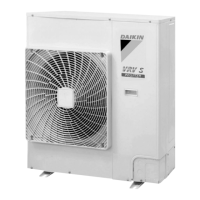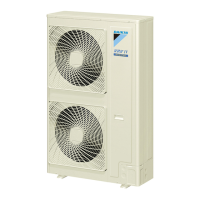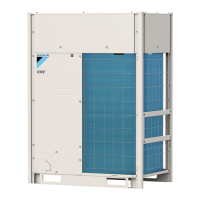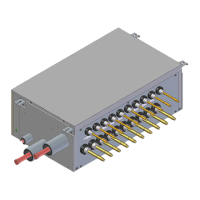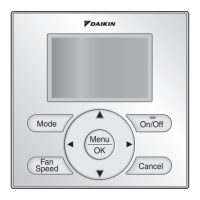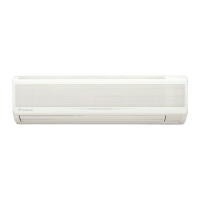20 | Electrical installation
Installer and user reference guide
107
RXYSA4~6A7V/Y1B
VRV 5-S system air conditioner
4P600330-1D – 2023.02
WARNING
▪ If the power supply has a missing or wrong N-phase, equipment might break
down.
▪ Establish proper earthing. Do NOT earth the unit to a utility pipe, surge absorber,
or telephone earth. Incomplete earthing may cause electrical shock.
▪ Install the required fuses or circuit breakers.
▪ Secure the electrical wiring with cable ties so that the cables do NOT come in
contact with sharp edges or piping, particularly on the high-pressure side.
▪ Do NOT use taped wires, extension cords, or connections from a star system.
They can cause overheating, electrical shock or fire.
▪ Do NOT install a phase advancing capacitor, because this unit is equipped with an
inverter. A phase advancing capacitor will reduce performance and may cause
accidents.
CAUTION
Do NOT push or place redundant cable length into the unit.
NOTICE
The distance between the high voltage and low voltage cables should be at least
50mm.
20.1.2 About the electrical wiring
NOTICE
▪ Keep the power line and transmission line apart from each other. Transmission
wiring and power supply wiring may cross, but may NOT run parallel.
▪ In order to avoid any electrical interference, the distance between both wirings
should ALWAYS be at least 50mm.
The interconnection wiring outside the unit should be wrapped and routed
together with the field piping.
Interconnection wiring specification and limits
(a)
See "20.1.6Specifications of standard wiring components"[4111] for wiring
requirements
Maximum number of branches for unit-to-unit cabling 9
Maximum wiring length
(distance between outdoor and furthest indoor unit)
300m
Total wiring length
(sum of distances between outdoor and all indoor units)
600m
(a)
If the total interconnection wiring exceeds these limits, communication errors might occur.
No secondary branching is allowed after any interconnection wire branching.

